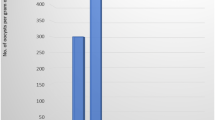Abstract
Chicks (1-d-old, three groups, each containing 50 chicks) were inoculated with 2×102 and 2×108 CFU ofSalmonella enteritidis; the third group were kept as uninoculated control. Five birds from each group were euthanized at intervals from 6 h to 4 weeks post-inoculation (pi). In the lowdose groupS. enteritidis was isolated from 60% cecal samples at 18 h pi. and from 20% of livers at 3 d pi. Individual variation in the frequency ofS. enteritidis recovery was observed in this group. The clearance of salmonella from the organs was faster in the low-dose group, and salmonella was not isolated from the liver and cecum at 21 and at 27 d, pi, respectively. However, in the high-dose group,S. enteritidis was isolated from all ceca and 80% of liver 6 h pi, and salmonella was detected in the cecum and liver throughout the experiment. Serous typhlitis and unabsorbed yolk sac were the most prevalent lesions in both groups. Granulomatous nodules in the cecum were found occasionally in some cases in both inoculated groups, which can play a role as reservoirs in carrier chicks.
Similar content being viewed by others
References
Brownell J.R., Sadler W.W., Fanelli M.J.: Role of caeca, in intestinal infection of chicken withSalmonella typhimurium.Avian Dis. 14, 106–116 (1970).
Bumstead N., Barrow P.: Resistance toSalmonella gallinarum, S. pullorum andS. enteritidis in inbred lines of chickens.Avian Dis.37, 189–193 (1993).
Chart H., Rowe B., Baskerville A., Humphrey T.J.: Serological response of chickens toSalmonella enteritidis infection.Epidemiol. Infectol. 104, 63–71 (1990).
Desmidt M., Ducatelle R., Haesebrouck F.: Pathogenesis ofSalmonella enteritidis PT4 after experimental infection of young chickens.Vet. Microbiol. 56, 99–109 (1997).
Duchet-Suchaxu M., Mompart F., Berthelot F., Beaumont C., Lechopier P., Pardon P.: Differences in frequency, level, and duration of caecal carriage between four outbreed chicken lines infected orally with SE.Avian Dis. 41, 559–567 (1997).
Gast R.K., Benson S.T.: The comparative virulence for chicks of SE PT4 and isolates of phage types commonly found in the United States.Avian Dis. 36, 567–574 (1995).
Gorham, S.I., Kadavil K., Vaughan E., Lambert H., Abel J., Pert B.: Gross and microscopic lesion in young chickens experimentally infected with SE.Avian Dis. 38, 816–821 (1994).
Guillot J.F., Beaumont C., Bellatif F., Mouline C., Lantier F., Colin P., Protas J.: Comparison of resistance of various poultry lines to infection byS. enteritidis.Vet. Res. 26, 81–86 (1995).
Humphrey T.J., Baskerville A.A., Mawer S., Rowe B., Hopper S.:Salmonella enteritidis PT4 from contents of intact eggs.: a study involving naturally infected hens.Epidemiol. Infectol..103, 415–423 (1989).
Nagaraja K.V., Pomeroy B.S., Williams, J.E.: Paratyphoid infection. pp. 99–130 in B.W. Calneket al. (Eds):Disease of Poultry. 9th ed. Iowa State University Press, Ames (USA) 1991.
O’Brien J.D.P.:Salmonella enteritidis infection in broiler chickens.Vet. Rec. 122, 214 (1988).
Protais J.P., Colin, J., Guillot F., Lantier F., Pardon P., Bennejean G.: Lines differences in resistance toSalmonella enteritidis PT4 infection.Brit. Pult. Sci. 37, 329–339 (1996).
Qin Z.R., Fukata T., Baba, E., Arakawa A.: Effect ofEimeria tenella onSalmonella enteritidis infection in chickens.Poult. Sci. 74, 1–7 (1995).
Timoney J.F., Shivaprasad H.L., Beker R.C., Rowe B.: Egg transmission after infection of hens withSalmonella enteritidis PT4.Vet. Rec. 125, 600–601 (1989).
Trebichavský I. Cytokines inSalmonella infection.Folia Microbiol. 44, 457–460 (1999).
Xu, Y.M., Pearson G.R., Hinton M.: The colonization of the alimentary tract and visceral organs of chicks with salmonellas following challengevia the feed: bacteriological findings.Brit. Vet. J. 144, 403–410 (1988).
Author information
Authors and Affiliations
Rights and permissions
About this article
Cite this article
Asheg, A.A., Fedorová, V., Pistl, J. et al. Effect of low and high doses ofSalmonella enteritidis PT4 on experimentally infected chicks. Folia Microbiol 46, 459–462 (2001). https://doi.org/10.1007/BF02814439
Received:
Issue Date:
DOI: https://doi.org/10.1007/BF02814439




